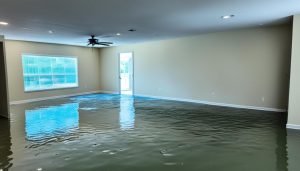Ever walked into your garage and found puddles or dampness on the floor? You might wonder, “why is the inside of my garage wet?” This problem, called garage condensation, happens more often than you think. It comes from different things inside and outside your garage.
Condensation is a big reason for this. It happens when moist air hits cold surfaces, forming water droplets. These droplets can cause a lot of damage over time. Things like running appliances without ventilation or parking a warm car inside can make the garage more moist. Also, condensation is more common in cold weather, especially right after it gets warmer.
This mix of conditions makes it easier to find out why your garage is wet. It’s important to fix these moisture issues to protect your garage and its contents. This way, your garage stays dry and useful.
Common Causes of Garage Moisture Issues
Finding out why garages get damp is key to keeping them dry. Moisture can lead to mold, mildew, and bad smells. These problems are hard to get rid of.
Temperature changes often cause moisture on garage floors, especially without vapor barriers. Weatherstripping on garage doors helps stop water from getting in. This is especially true after rain or snowmelt from cars.
Garages without good air flow tend to get humid. This makes it harder to fix dampness. The type of roof also affects how much moisture gets in. Materials like rubber or galvanized steel are better than others.
Leaks are a big problem. Water can get in through bad seals around windows and doors, and through cracks in concrete or wood. Roof damage from storms or neglect can also cause water issues. Keeping garage door seals tight and filling gaps can help.
Garages often have plumbing, HVAC systems, and water heaters, which can leak. Keeping these systems in good shape is important. Also, making sure the property drains well and the driveway slopes away from the garage helps control moisture.
Garages built by companies like Danley’s are designed to be dry. They use waterproofing like concrete sealants or paint. Homeowners can also make their garages drier by fixing these common problems.
Preventing Garage Water Damage
To keep your garage dry, there are key steps to take. These actions can protect your garage from water problems.
- Heating Solutions: Keeping your garage warm can cut down on moisture. This is a big step in stopping water leaks.
- Vapor Barriers and Insulation: Adding vapor barriers and insulation helps keep moisture out. This is vital for a dry garage.
- Drainage Systems: Make sure your garage and roof drains work well. This keeps water away from your garage.
- Dehumidifiers and Ventilation: Using dehumidifiers and keeping the garage well-ventilated lowers humidity. This helps prevent water damage.
- Organizational Improvements: Clearing clutter and using waterproof storage helps air flow. Installing shelving also protects items from leaks.
More ways to stop leaks include using waterproof paint or epoxy on walls and floors. Epoxy is better for water resistance, but some paints work well too.
Applying tanking slurry on walls is another affordable way to waterproof. It costs less than $50 for a 20-kg bucket.
Regular checks for water damage signs are crucial. Look for stains, puddles, rust, and floor cracks. Catching problems early saves money and hassle.
By following these steps, you can keep your garage dry and safe from water damage. This makes your garage a dry, protected space.
Why is the inside of my garage wet?
When figuring out why your garage is wet, many things can cause moisture. Knowing these can help you fix the problem.
- Concrete Flooring: Garages often have concrete floors. These can pull water from the ground after a storm, making puddles inside.
- Garage Door Seals: Water near the garage door means the seals are not working right. They might need to be replaced.
- Negative Yard Grading: If your yard slopes towards the garage, water can flow in. A U-shaped drain on the driveway can help keep water out.
- Appliances: Old appliances like water heaters and HVAC systems in the garage can leak. This adds to the moisture.
- Foundation Cracks: Water can get in through cracks between the foundation and slab, causing puddles. Sealing these with caulk that keeps water out is key.
- Roof Damage: Storms can damage roofs, leading to leaks. Make sure gutters are clean to stop water overflow and leaks.
- Plumbing Issues: Plumbing in garage walls and ceilings can leak. You’ll need a pro to fix it.
To control moisture in garages, start by fixing these common problems. By finding and fixing the source of dampness, you can keep your garage dry. Adding weather seals, keeping drains clear, fixing damage fast, and thinking about waterproofing can help. These steps can make your garage a dry and useful space.
Conclusion
To keep your garage dry and useful, it’s important to tackle moisture problems head-on. Garages often face issues like water damage and mold if not managed well. Problems like high moisture, lack of sunlight, poor insulation, and bad weather can make things worse.
Signs of moisture, such as stains, peeling paint, or damaged seals, need to be watched for. Installing threshold seals and ensuring the driveway slopes away from the garage can help. Fixing cracks and keeping gutters clear are also key steps.
Using concrete sealant, waterproof paint, or tanking slurry can add extra protection. It’s vital to deal with moisture quickly to prevent damage and health risks. Getting expert water damage advice can help keep your garage in good shape for years.
By following these tips, you can keep your garage dry and your belongings safe. It’s better to prevent problems than to fix them after they happen. Regular checks and quick action are essential for a dry, safe garage.








